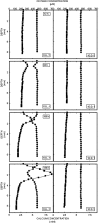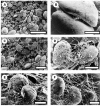Light-dependant biostabilisation of sediments by stromatolite assemblages
- PMID: 18781202
- PMCID: PMC2526175
- DOI: 10.1371/journal.pone.0003176
Light-dependant biostabilisation of sediments by stromatolite assemblages
Abstract
For the first time we have investigated the natural ecosystem engineering capacity of stromatolitic microbial assemblages. Stromatolites are laminated sedimentary structures formed by microbial activity and are considered to have dominated the shallows of the Precambrian oceans. Their fossilised remains are the most ancient unambiguous record of early life on earth. Stromatolites can therefore be considered as the first recognisable ecosystems on the planet. However, while many discussions have taken place over their structure and form, we have very little information on their functional ecology and how such assemblages persisted despite strong eternal forcing from wind and waves. The capture and binding of sediment is clearly a critical feature for the formation and persistence of stromatolite assemblages. Here, we investigated the ecosystem engineering capacity of stromatolitic microbial assemblages with respect to their ability to stabilise sediment using material from one of the few remaining living stromatolite systems (Highborne Cay, Bahamas). It was shown that the most effective assemblages could produce a rapid (12-24 h) and significant increase in sediment stability that continued in a linear fashion over the period of the experimentation (228 h). Importantly, it was also found that light was required for the assemblages to produce this stabilisation effect and that removal of assemblage into darkness could lead to a partial reversal of the stabilisation. This was attributed to the breakdown of extracellular polymeric substances under anaerobic conditions. These data were supported by microelectrode profiling of oxygen and calcium. The structure of the assemblages as they formed was visualised by low-temperature scanning electron microscopy and confocal laser microscopy. These results have implications for the understanding of early stromatolite development and highlight the potential importance of the evolution of photosynthesis in the mat forming process. The evolution of photosynthesis may have provided an important advance for the niche construction activity of microbial systems and the formation and persistence of the stromatolites which came to dominate shallow coastal environments for 80% of the biotic history of the earth.
Conflict of interest statement
Figures







Similar articles
-
Bacterially mediated precipitation in marine stromatolites.Environ Microbiol. 2001 Feb;3(2):123-30. doi: 10.1046/j.1462-2920.2001.00168.x. Environ Microbiol. 2001. PMID: 11321542
-
Molecular and morphological characterization of cyanobacterial diversity in the stromatolites of Highborne Cay, Bahamas.ISME J. 2009 May;3(5):573-87. doi: 10.1038/ismej.2008.129. Epub 2009 Jan 15. ISME J. 2009. PMID: 19148145
-
Microbial diversity in modern marine stromatolites, Highborne Cay, Bahamas.Environ Microbiol. 2009 Oct;11(10):2710-9. doi: 10.1111/j.1462-2920.2009.01998.x. Epub 2009 Jul 6. Environ Microbiol. 2009. PMID: 19601956
-
Stromatolites in Precambrian carbonates: evolutionary mileposts or environmental dipsticks?Annu Rev Earth Planet Sci. 1999;27:313-58. doi: 10.1146/annurev.earth.27.1.313. Annu Rev Earth Planet Sci. 1999. PMID: 11543060 Review.
-
The paleobiological record of photosynthesis.Photosynth Res. 2011 Jan;107(1):87-101. doi: 10.1007/s11120-010-9577-1. Epub 2010 Jul 7. Photosynth Res. 2011. PMID: 20607406 Free PMC article. Review.
Cited by
-
Microbial Extracellular Polymeric Substances (EPSs) in Ocean Systems.Front Microbiol. 2017 May 26;8:922. doi: 10.3389/fmicb.2017.00922. eCollection 2017. Front Microbiol. 2017. PMID: 28603518 Free PMC article. Review.
-
Transition from stromatolite to thrombolite fabric: potential role for reticulopodial protists in lake microbialites of a Proterozoic ecosystem analog.Front Microbiol. 2023 Oct 30;14:1210781. doi: 10.3389/fmicb.2023.1210781. eCollection 2023. Front Microbiol. 2023. PMID: 37965561 Free PMC article.
-
Microbially induced sedimentary structures in evaporite-siliciclastic sediments of Ras Gemsa sabkha, Red Sea Coast, Egypt.J Adv Res. 2014 Sep;5(5):577-86. doi: 10.1016/j.jare.2013.07.009. Epub 2013 Aug 2. J Adv Res. 2014. PMID: 25685526 Free PMC article.
-
Microbial extracellular polymeric substances (EPS) in fresh water sediments.Microb Ecol. 2009 Aug;58(2):334-49. doi: 10.1007/s00248-009-9498-8. Epub 2009 Feb 26. Microb Ecol. 2009. PMID: 19242746
-
Emerging technologies for non-invasive quantification of physiological oxygen transport in plants.Planta. 2013 Sep;238(3):599-614. doi: 10.1007/s00425-013-1926-9. Epub 2013 Jul 12. Planta. 2013. PMID: 23846103
References
-
- Loreau M, Naeem S, Inchausti P. Biodiversity and ecosystem functioning: Synthesis and perspectives. Oxford: 2004.
-
- Chapin FS, Walker BH, Hobbs RJ, Hooper DU, Lawton JH, et al. Biotic control over the functioning of ecosystems. Science. 1997;277:500.
-
- Dupraz C, Visscher PT. Microbial lithification in marine stromatolites and hypersaline mats. Trends in Microbiology. 2005;13:429–438. - PubMed
-
- Visscher PT, Stolz JF. Microbial mats as bioreactors: populations, processes, and products. Palaeogeography, Palaeoclimatology and Palaeoecology. 2005;219:87–100.
Publication types
MeSH terms
Substances
LinkOut - more resources
Full Text Sources

